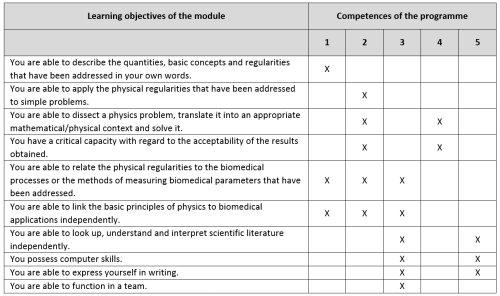Congruence table
As a teacher, you are responsible, at least in part, for one or more courses. When determining the content, design and assessment of a course, it is important to consider the larger whole within which that course fits: the programme curriculum. One tool you can use to help you align your course with the programme curriculum is to complete a 'congruence table'.
How does it work?
- Look up the learning outcomes of the programme in which you are teaching. They can usually be found on the UAntwerp website. If necessary, you can ask one of the programme coordinators.
- Keep the list of learning outcomes for your course at hand. For a new course, these learning outcomes need to be constructed.
- Create a congruence table in which you relate the course learning outcomes to the programme learning outcomes: which programme learning outcomes are you trying to address through the course learning outcomes, and which ones are you not addressing? Most importantly, can you justify these choices? (For example, because your course is not practical, there may not be a learning outcome that contributes to a programme learning outcome related to practical-experimental skills).Create a table in which the course learning outcomes are positioned in relation to the programme learning outcomes: which programme learning outcomes do you seek to achieve through the course learning outcomes, and which do you not address? Most importantly, can you justify these choices? (For example, because your course is not a practical, there might not be a learning outcome that contributes to a programme learning outcome with regard to practical-experimental skills.)
- If so, the learning outcomes of your course are consistent with the programme learning outcomes and your course contributes to their achievement.
- If not, this indicates a discrepancy between the learning outcomes of your course and the programme learning outcomes. This is a reason to reconsider the learning outcomes (and consequently the associated content, design and assessment) of your course and/or to discuss the identified discrepancy with your colleagues or the programme coordinator.

If every teacher in a programme completes this exercise, it will be possible to determine the extent to which the programme learning outcomes are sufficiently covered by the different courses (and their learning outcomes). If certain programme learning outcomes are not addressed, or are only addressed in a summary manner, it will be necessary to consider how to remedy this situation. Each programme learning outcome should be of central importance (and therefore assessed) in at least one course (and preferably in more than one). This will also help to identify excessive overlap. In the future, teachers working on the same learning outcomes could collaborate where possible, thereby achieving greater integration between courses in a curriculum.
Constructive alignment for courses
Developing a course is not an easy task. Lecturers are regularly confronted with a number of questions and difficulties, such as: "How do I know which teaching methods are appropriate for this course? In the following section, we present some tips that may help you in the further development of a course:
- Formulate clear learning outcomes
As an initial step, formulate clear learning outcomes that you would like for the students to have achieved by the end of the course. These learning outcomes should be congruent with a number of learning outcomes that have been formulated at the programme level. The following could be an example of a learning outcome within the course 'General Psychology': ‘Students are able to explain the behaviour of people in simple situations in terms of psychological mechanisms’.
- Select teaching methods
Select teaching methods that will help students to achieve the specified learning outcomes. For example, in relation to the learning outcome above, a suitable teaching method might be a case assignment in which students are asked to explain certain behaviours. Students need to explain the behaviour presented in the case in terms of psychological mechanisms that have been covered in the course so far. When choosing teaching methods, it is also important to consider several conditions, including the characteristics of the students (e.g. size of the group of students, level of education of the students). Some teaching methods are more suitable for large groups than for small groups. It is easier to carry out a case study with a small group of students than with a large group of students. Contextual factors are also important when choosing teaching methods. Some teaching methods require a certain type of infrastructure (e.g. separate tables and chairs or an overhead projector).
- Select an assessment method
Select an assessment method that will assess the stated learning outcomes in an appropriate way. Applying this to the learning outcome above, it is clear that a knowledge test that focuses exclusively on students' knowledge of psychological mechanisms would not be appropriate. A more appropriate form would be a case test in which students are presented with a situation and asked to explain behaviour in terms of psychological mechanisms. It is also important to maintain congruence between the nature of the assessment and the teaching methods used in the course throughout the academic year. If you decide to assess students on the basis of case exercises, it is important to give students the opportunity to practise this throughout the academic year.